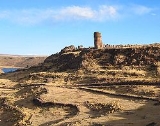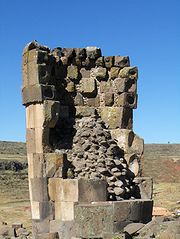
Sillustani
Encyclopedia
Sillustani is a pre-Incan
burial ground
on the shores of Lake Umayo
near Puno
in Peru
. The tombs, which are built above ground in tower-like structures called chullpa
s, are the vestiges of the Colla people, Aymara who were conquered by the Inca in the 15th century. The structures housed the remains of complete family groups, although they were probably limited to nobility. Many of the tombs have been dynamited by grave robbers
, while others were left unfinished.
 Ancestor worship and kinship were integral parts of Aymara culture, and the huge chullpas or "chulpa" at Sillustani were built to house the Aymara elite of the immediate pre-Inca and Inca period. There was used in the 19th century and comes from the Dictionary of Ludovico Bertonio (1612). Bertonio referred to the basket burials of the semi-nomadic pastoralists as "chulpas" and actually referred to stone towers as "uta Amaya" "houses of the soul". However, the term "chullpa" remains used today for the towers.
Ancestor worship and kinship were integral parts of Aymara culture, and the huge chullpas or "chulpa" at Sillustani were built to house the Aymara elite of the immediate pre-Inca and Inca period. There was used in the 19th century and comes from the Dictionary of Ludovico Bertonio (1612). Bertonio referred to the basket burials of the semi-nomadic pastoralists as "chulpas" and actually referred to stone towers as "uta Amaya" "houses of the soul". However, the term "chullpa" remains used today for the towers.
Many of the chullpas at Sillustani show pre-Inca characteristics that were later redressed with Inca stone blocks. Similar chullpas are found throughout the entire south Central Andes with the above ground burial styles going back at least to mature Tiwanaku (ca AD 500-950). The insides of the tombs were built to hold entire groups of people, most likely extended families of the Aymara elite. Corpses were not intentionally mummified, but in the dry environment created by the closed tomb, they survived for centuries. Most mummy bundles indicate burial in a fetal position
. Some of the tombs also have various animal shapes carved into the stone. The only openings to the buildings face east, where it was believed the Sun
was reborn by Mother Earth each day.
. In contrast with the Inca, who used stones of varying shapes, the Colla used even rectangular edges. While chullpas are not unique to Sillustani and are found across the Altiplano
, this site is considered the best and most preserved example of them.
Inca Empire
The Inca Empire, or Inka Empire , was the largest empire in pre-Columbian America. The administrative, political and military center of the empire was located in Cusco in modern-day Peru. The Inca civilization arose from the highlands of Peru sometime in the early 13th century...
burial ground
Cemetery
A cemetery is a place in which dead bodies and cremated remains are buried. The term "cemetery" implies that the land is specifically designated as a burying ground. Cemeteries in the Western world are where the final ceremonies of death are observed...
on the shores of Lake Umayo
Lake Umayo
Lake Umayo is a lake in the Puno Region of Peru. The shores of the lake house Sillustani burial ground....
near Puno
Puno
Puno is a city in southeastern Peru, located on the shore of Lake Titicaca. It is the capital city of the Puno Region and the Puno Province with a population of approximately 100,000. The city was established in 1668 by viceroy Pedro Antonio Fernández de Castro as capital of the province of...
in Peru
Peru
Peru , officially the Republic of Peru , is a country in western South America. It is bordered on the north by Ecuador and Colombia, on the east by Brazil, on the southeast by Bolivia, on the south by Chile, and on the west by the Pacific Ocean....
. The tombs, which are built above ground in tower-like structures called chullpa
Chullpa
A chullpa is an ancient Aymara funerary tower originally constructed for a noble person or noble family. The tallest are about 12m high. The tombs at Sillustani are most famous, but chullpas are found across the Altiplano in Peru and Bolivia...
s, are the vestiges of the Colla people, Aymara who were conquered by the Inca in the 15th century. The structures housed the remains of complete family groups, although they were probably limited to nobility. Many of the tombs have been dynamited by grave robbers
Grave robbing
Grave robbery, grave robbing, or tomb raiding is the act of uncovering a tomb or crypt to steal artifacts or personal effects. Someone who engages in this act is a grave robber or tomb raider...
, while others were left unfinished.
Chullpa

Many of the chullpas at Sillustani show pre-Inca characteristics that were later redressed with Inca stone blocks. Similar chullpas are found throughout the entire south Central Andes with the above ground burial styles going back at least to mature Tiwanaku (ca AD 500-950). The insides of the tombs were built to hold entire groups of people, most likely extended families of the Aymara elite. Corpses were not intentionally mummified, but in the dry environment created by the closed tomb, they survived for centuries. Most mummy bundles indicate burial in a fetal position
Fetal position
Fetal position is a medical term used to describe the positioning of the body of a prenatal fetus as it develops...
. Some of the tombs also have various animal shapes carved into the stone. The only openings to the buildings face east, where it was believed the Sun
Sun
The Sun is the star at the center of the Solar System. It is almost perfectly spherical and consists of hot plasma interwoven with magnetic fields...
was reborn by Mother Earth each day.
Architecture
The architecture of the site is often considered more complex than typical Incan architectureIncan architecture
Incan architecture is the most significant pre-Columbian architecture in South America. The Incas inherited an architectural legacy from Tiwanaku, founded in the 2nd century BCE in present day Bolivia...
. In contrast with the Inca, who used stones of varying shapes, the Colla used even rectangular edges. While chullpas are not unique to Sillustani and are found across the Altiplano
Altiplano
The Altiplano , in west-central South America, where the Andes are at their widest, is the most extensive area of high plateau on Earth outside of Tibet...
, this site is considered the best and most preserved example of them.

